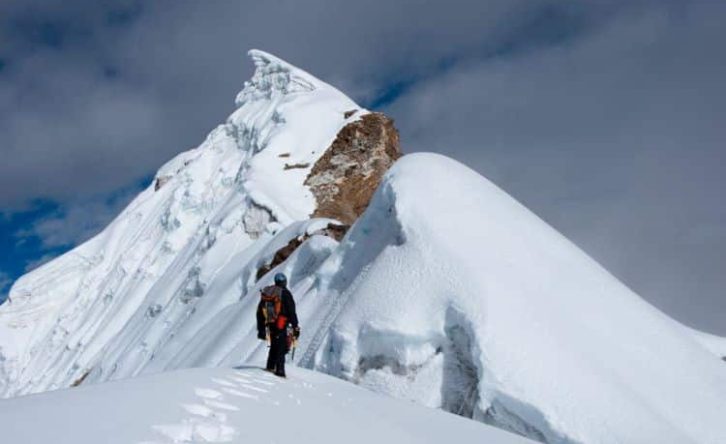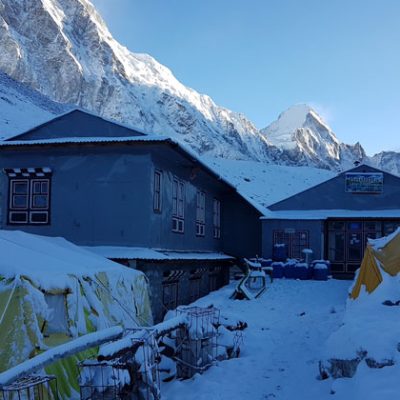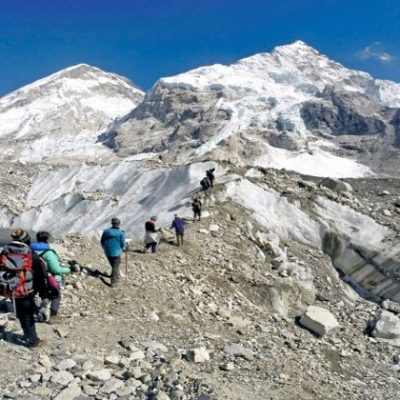Overview
Island Peak Climbing is one of the most popular trekking peak expeditions in Nepal. This peak, also known as Imja Tse, stands at an altitude of 6,189 meters (20,305 feet) and is a practice peak for mountaineers who are planning to scale the highest peak in the world, Mt. Everest. We bring this 2-Day Island Peak Climbing from Chhukung, the most exciting and short side trip package for you.
This exciting trekking peak in the 6,000-meter class is also perfect for testing your mountaineering skills if you are a beginner and looking to gain some experience before big expeditions. You will have to overcome a few technical slopes on the straightforward route, and you can complete the expedition without the need to camp out even a single night at its slope.
So, if you are already on an exploration of the mighty Everest region, you can add this 2 days extra itinerary plan to your exciting Himlayan exploration. This side detour of the Khumbu Valley is best suited for climbers looking forward to honing their skills or trekking enthusiasts who want to extend their Himalayan adventure prospects.
Best Time for Island Peak Climbing
The months of March to May (spring) and September to November (autumn) are considered the best periods for Island Peak climbing. These months fall under the peak seasons, spring and autumn, which are the top choices for mountain expeditions and Himalayan trekking adventures in Nepal.
These months have the most suitable climatic conditions and offer a perfect window frame for mountain expeditions with less troublesome high winds. The spring season is popular as the peak season of nature, and you can expect the trails to be spectacularly decorated with sotted rhododendrons flowers and other colorful natural allurements.
The temperature of the Everest region is around 17°C to 25°C at the lower trekking trails. As for the autumn season, it is mostly popular for the dry, comfortable trekking and clear views of the Himalayan vistas. The region’s temperature during the autumn season hovers around 11°C 20°C on the trekking trail.
The temperatures at the alpine altitudes drop to minus degrees during the early morning and nights at alpine altitudes in both seasons.
Pre Training
To add comfort level to your expedition, it is necessary to prepare right for the expedition. However, if you have general trekking experience, then it will be sufficient for this Himalayan expedition. We have many records where climbers have successfully completed the Island Peak Climbing in their first climbing experience.
In case you don’t have any trekking experience, you can design an efficient preparation program suited for high-altitude treks, which will be enough for this mountain scaling. Doing a proper physical assessment is the most effective way to design a suitable training period for the climb. Strength, endurance, and stamina training should be your top priority as you will trek for a long duration before scaling the mountain.
You can include exercises like squats, push up, pull up, deadlines, weight lifts, bicep curls, bench presses, overhead presses, dip, etc, for strength training. As for stamina training, jogging, practice hikes, swimming, dancing, cycling, jumping rope, high knees, aerobics, cardio, etc are the most effective exercises.
Also, even though the technical sections on the mountain are pretty much and are not that demanding, you are still recommended to learn some mountaineering skills. Learning some snow skills will also certainly be helpful during your expedition.
Chukung to Island Peak Climbing Itinerary
Cost Includes / Exclude
What’s include
- Climbing Permit
- A Professional Climbing guide ( 1 guide for 2 Members)
- Simple meals – Breakfast, Lunch, Dinner)
- Climbing Guide Insurance
- Tented Camp Accommodation
- Climbing Gears ( like rope, Ice axe, Climbing Harness, Crampons etc)
- All government taxes.
- Service charge.
What’s excluded
- Personal Travel Insurance
- Porter
- Tips





